|
|
|
Sort Order |
|
|
|
Items / Page
|
|
|
|
|
|
|
| Srl | Item |
| 1 |
ID:
145805
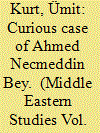

|
|
|
|
|
| Summary/Abstract |
Ahmed Necmeddin Bey was the kaimakam (district governor) of Aintab in late July 1908. One day, however, Ahmed Necmeddin Bey was beaten by a group of Turks and Armenians in Aintab; his clothes torn, he was dismissed from his post and finally expelled him from the city. But what was the reason for this incident? Within the first year of the declaration of the Constitution, it was the most important event that occurred in the city. This particular incident calls for careful examination, for this significant event reflects how the Second Constitutional era and the new regime were perceived by Muslims and Armenians in Aintab on a local level. Additionally, it offers us some useful clues regarding how the Union and Progress Party as a political organization and its policies were received on a local scale. By studying this case, it is also possible to see a clear example of how ordinary Ottoman citizens reacted towards the revival of the Constitution.
|
|
|
|
|
|
|
|
|
|
|
|
|
|
|
|
| 2 |
ID:
121532
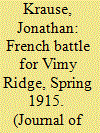

|
|
|
|
|
| Publication |
2013.
|
| Summary/Abstract |
The unprecedented scale of trench warfare in the First World War posed a series of challenges to attacking forces. This article tracks the early French steps to develop a coherent doctrine for launching offensives against established trench systems, focusing on a specific battle in May-June 1915: Second Artois. This battle would be the first based on lessons learned and digested by the French army after its initial tentative efforts at trench warfare from December 1914 to March 1915. As such it provides an interesting starting point for an analysis of the French army's development of trench tactics in the First World War and of the part this played in the general effort made by the two sides to find ways to break the post-1914 stalemate on the Western Front.
|
|
|
|
|
|
|
|
|
|
|
|
|
|
|
|
| 3 |
ID:
137949
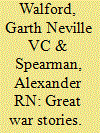

|
|
|
|
|
| Summary/Abstract |
As the Great War entered 1915, the stalemate continued unabated on the Western Front. In an attempt to force the Central Powers’ hand, Winston Churchill – then First Lord of the Admiralty – developed plans to drive the Ottomans out of the war and, potentially, to bring Greece and Bulgaria in on the side of the Allies. He proposed a naval attack on the Dardanelles, which would expose Istanbul and open up a supply route with Russia.
|
|
|
|
|
|
|
|
|
|
|
|
|
|
|
|
| 4 |
ID:
141791
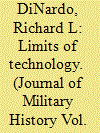

|
|
|
|
|
| Summary/Abstract |
The invasion of Serbia in October 1915 saw the Serbian army, which had fought off three separate invasions by Austria-Hungary the year before, driven out of Serbia within six weeks. A critical land route to Turkey and Bulgaria was opened, and Austria-Hungary’s southern flank was secured. The forces of the Central Powers made extensive use of the most modern technology of the day—including railroads, bridging, aircraft, artillery and telephone—and demonstrated their potential. This article suggests that while they gave the Central Powers a major edge early, the campaign also revealed the limits of these technologies.
|
|
|
|
|
|
|
|
|
|
|
|
|
|
|
|
| 5 |
ID:
187242
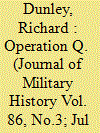

|
|
|
|
|
| Summary/Abstract |
British strategy during the First World War has long been a contentious issue, and whether the nation’s sea power could have been used to greater effect lies at the heart of the debate. This article presents new evidence to show that both Winston Churchill and Admiral Lord Fisher, the key figures in the Admiralty in the opening year of the war, focused on implementing a naval offensive against Germany throughout their time in office. The first stages of this operation came within hours of execution in May 1915. This revelation sheds new light on the wider British strategic approach and on the significance of the fall of the Fisher-Churchill regime for Britain’s grand strategy.
|
|
|
|
|
|
|
|
|
|
|
|
|
|
|
|
| 6 |
ID:
179016
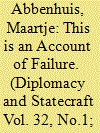

|
|
|
|
|
| Summary/Abstract |
The Hague conferences of 1899, 1907 and the one not held in 1915 occupy an uncomfortable place in the history of war, peace, and diplomacy. Siloed in a range of sub-disciplines, historians often evaluate the conferences in terms of their relative ‘success’ or ‘failure’. Where diplomatic historians generally marginalise the political relevance of the conferences in explaining the march to global war in 1914, legal historians mobilise The Hague as a point of origin for the expansion of international humanitarian and human rights law and the law of war. Peace historians prefer to explain the relative weakness of pre-1914 transnational peace activism, whilst historians of global governance describe The Hague as a starting point for twentieth century multilateralism. Rarely do these histories speak to each other, which leaves their largely oppositional findings floating freely, untethered to either each other or the complex context in which The Hague’s conferences, conventions, and institutions evolved. In response, this analysis argues for the historical need to re-tether these Hague developments to the context of the time in which they first appeared, thus helping to shape a more nuanced understanding of their on-going political and legal relevance as well.
|
|
|
|
|
|
|
|
|
|
|
|
|
|
|
|
|
|
|
|
|